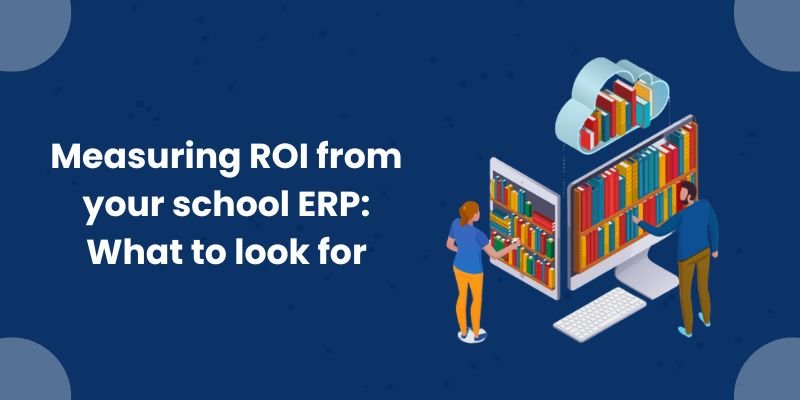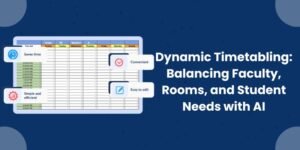In an age where schools are increasingly turning to technology for operational efficiency, a robust School ERP system has become more than just a digital ledger—it’s a strategic asset. But when school leaders greenlight an ERP investment, one crucial question inevitably follows: Is it worth it?
The answer lies in understanding and evaluating the Return on Investment (ROI)—not just in terms of money, but also in time saved, stress reduced, data accuracy, staff and parent satisfaction, and long-term scalability.
In this blog, we’ll walk you through what ROI truly means for educational institutions using ERP, and what factors to monitor to assess whether your school is getting real value from its system.
What Is ROI in the Context of a School ERP?
ROI in education technology, especially ERP, is about assessing the overall benefit you derive in relation to the investment made. These benefits can be direct—like cost savings on paper and administrative time—or indirect—such as enhanced decision-making and parent satisfaction.
When your ERP helps reduce redundancies, automate processes, and offer real-time insights, it saves time and resources. That saved time translates into better productivity, higher stakeholder satisfaction, and stronger learning outcomes.
But ROI isn’t always immediately obvious. That’s why school leaders must look beyond just monetary gains to evaluate long-term institutional benefits.
Reduction in Administrative Load
One of the most immediate impacts of ERP implementation is the reduction of administrative effort. Tasks that previously required hours—such as creating student report cards, tracking attendance, managing fee structures, or generating timetables—are automated with a few clicks.
This allows administrative staff and teachers to shift focus from paperwork to people. The time saved per day or per week adds up, creating a significant gain in operational productivity.
Moreover, many schools report a measurable reduction in the need for temporary staffing or overtime after ERP adoption. These savings are real and contribute directly to ROI.
Data Accuracy and Centralised Information
Another way school ERP systems improve ROI is by enhancing data integrity. Before ERP, schools typically relied on Excel sheets, physical registers, or multiple software platforms that didn’t sync. This not only consumed more time but also increased the chances of duplication and error.
With an ERP, schools can maintain a centralised database where updates made in one place are reflected everywhere. Student profiles, academic histories, financial transactions, and teacher records are stored securely and consistently.
This data centralisation enables accurate reporting and compliance, especially when dealing with audits or regulatory bodies.
Decreased Operational Costs
Although the upfront cost of a good school ERP system can seem significant, the long-term operational cost savings make it worthwhile.
Printing costs are one of the first areas where schools notice savings. Circulars, report cards, fee receipts, attendance registers, and even exam papers can be digitised. This saves not only paper and ink but also storage space and retrieval time.
Additionally, ERP systems reduce dependency on IT specialists for tasks like database management or report generation, because these features are built into the system itself.
Faster and More Transparent Fee Collection
Fee collection is one of the most sensitive and important parts of school management. Delays or inefficiencies can affect cash flow and require manual follow-ups that frustrate both staff and parents.
A modern school ERP integrates with online payment gateways and automates notifications for dues and receipts. Real-time tracking of collections, defaulters, and discounts ensures transparency and improves revenue management.
When the finance team has to spend less time chasing payments or reconciling accounts, it contributes significantly to both cost-efficiency and trust.
Enhanced Stakeholder Communication
A well-implemented ERP doesn’t just serve the staff—it becomes a communication bridge between school, students, and parents. Portals or mobile apps provide real-time access to information on grades, attendance, homework, school events, and more.
This transparency improves parent engagement, especially for those who may not always be able to visit the school in person. When parents feel informed and involved, their confidence in the institution grows. This can lead to better student retention and even positive word-of-mouth promotion.
Supporting Smarter Decision-Making
School leaders often have to make high-stakes decisions—how to allocate the budget, where to hire more staff, which departments need academic intervention.
ERP analytics can offer actionable insights here. Dashboards present trends in attendance, performance, teacher workloads, and fee defaulters at a glance. With access to historical and real-time data, decisions become less reactive and more strategic.
For example, identifying a consistent dip in attendance for certain classes during a particular month might reveal scheduling issues or underlying concerns. Such insights are nearly impossible to extract manually but are easy to obtain with the right ERP system.
Long-Term Scalability and Adaptability
A major advantage of a school ERP is its ability to grow with your institution. Whether you’re adding new grades, expanding campuses, or introducing online learning modules, a scalable ERP system can accommodate these changes without requiring a complete overhaul.
This scalability translates to reduced transition costs in the future and a stable digital infrastructure your staff and students can rely on. It also allows for custom workflows, report templates, and role-based access—ensuring that the system reflects your school’s unique DNA.
Calculating ERP ROI: What Numbers Matter?
While many benefits of ERP are qualitative, you can quantify ROI using a basic formula:
ROI = (Annual Savings + Measurable Benefits – Total Cost of ERP) / Total Cost of ERP × 100
Some measurable benefits include:
- Reduction in overtime costs
- Decrease in printing and stationery expenses
- Improved fee collection timelines
- Reduced time for administrative tasks
- Increase in parent satisfaction survey scores
- Better staff retention rates due to easier workloads
Even if your financial ROI is modest, your institutional ROI—measured in smoother processes and stronger relationships—is often invaluable.
Making ERP ROI a Team Priority
One of the most common reasons institutions don’t realise full ERP ROI is underutilisation. After implementation, staff may continue old manual processes, ignore features, or resist change.
To avoid this, it’s essential to:
- Offer ongoing training sessions
- Regularly review usage analytics
- Encourage feedback from teachers and staff
- Promote leadership buy-in
- Continuously explore new modules or customisations
When everyone—from the principal to the clerk—understands how the ERP makes their work easier, adoption naturally improves.
In education, we measure success not just in savings but in impact. A thoughtfully chosen and well-used ERP system delivers ROI not just by trimming expenses—but by making schools more agile, accountable, and future-ready.
It enables transparency, supports growth, and frees up valuable time that can be redirected toward what truly matters: learning.












